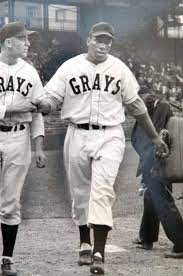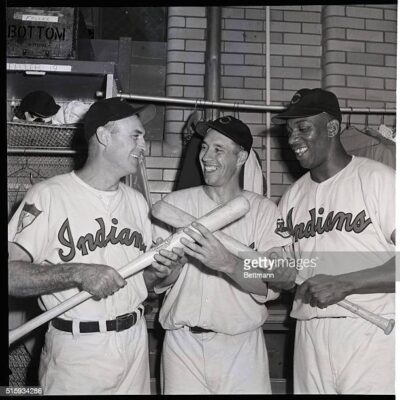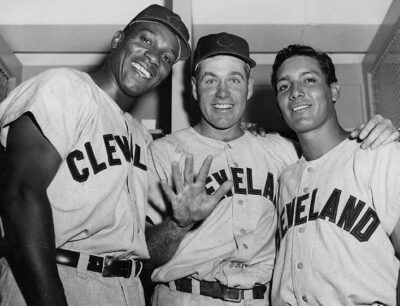Baseball History Comes Alive Now Ranked #2 by Feedspot Among All Internet Baseball History Websites and Blogs!
Guest Submissions from Our Readers Always Welcome!
Scroll Down to Read Today’s Essay
Subscribe to Baseball History Comes Alive for automatic updates. As a Free Bonus, you’ll get instant access to my Special Report: Gary’s Handy Dandy World Series Reference Guide!
Luke Easter Photo Gallery
Click on any image below to see photos in full size and to start Photo Gallery
It’s Easter Sunday…So Let’s Salute Luke Easter!
“Luke Easter is the only player I ever saw who can hit a baseball as far as Babe Ruth” –Jimmy Reese
…And that’s saying a lot coming from a former teammate of Babe Ruth!
As many of you are aware, I always try to find a connection between baseball history and holidays. With today being Easter Sunday, I was hoping to find a long-ago photo of Babe Ruth maybe clad in an Easter bunny costume. Alas, my Google search using the keywords, “Babe Ruth and Easter” came up empty.
But a name that did pop up was that of Luscious “Luke” Easter, a fine ballplayer from the Negro Leagues who also made it to the majors (1949-’54), benefiting from Jackie Robinson breaking baseball’s odious color barrier. So I thought to myself: “What better way to celebrate Easter Sunday than to turn our baseball spotlight on Luke Easter!” shown above on right with teammate Larry Doby.
As always when you dig past the surface and go deeper into the career of any ballplayer, you’ll discover many interesting facts of which you were previously unaware. That was certainly the case with my examination of the career of Luke Easter.

Start with the fact that Luke was a huge man. Standing 6’4” tall, he topped the scales at a massive 240 pounds. Early in life, the Jonestown, Mississippi native built a reputation as a big strong kid who could hit the ball a long way. Dropping out of school after the ninth grade, he began attracting attention and turning heads as a left-handed power-hitting first baseman while playing for numerous black industrial teams.
As happened to many budding stars from that era, World War II rudely interrupted, putting career aspirations on hold. Such was the case for Luke Easter who served until 1943. After his release from the Army and subsequent employment with defensive contractors, he was passed over after tryouts with two Negro National League teams. “He’s too big and too awkward to be an effective player,” so said legendary Negro League manager Jim “Candy” Taylor. But after a 1946 stint with Abe Saperstein’s black touring team, the Cincinnati Crescents, he was picked up by the Homestead Grays. Two highly successful years with the Grays followed, including hitting .363 in 1948 and leading the league in home runs and RBIs. He then starred for the Grays in their 1948 Negro League World Series championship.
Not surprisingly, his success caught the attention of Bill Veeck, the gadfly owner of the Cleveland Indians, who soon purchased Easter’s contract. A knee injury prevented him from landing a roster spot with the 1949 Indians, but he continued to star while playing for the San Diego Padres of the Pacific Coast League where he blasted 25 homers, with 80 RBIs, and again hit .363. This paved the way for Easter to crack the Indians’ 1950 lineup. So convinced were the Indians of his potential that they felt confident in trading away star Mickey Vernon to open up a spot for Easter at first base.
They were not disappointed. As a 34-year-old rookie, Easter continued his power hitting, ranking among the league leaders in home runs (28) and RBIs (107). He continued to produce in 1951 (27 home runs), and in 1952 (31 home runs), but nagging, recurrent injuries and advancing age slowed him down in 1953. After playing in only six games in 1954, his major league career was over. In eight seasons in the Big Show, the two-time All-Star hit a respectable .276, with 104 homers, 413 RBIs, along with a fine .356 on-base percentage. We can only speculate as to what his career numbers would look like had he been allowed to break into the major league at a much younger age, rather than as a 34-year-old rookie.
But his professional career was not over. He continued playing and starring in the minor leagues, including winning the 1957 International League MVP award while playing for the Buffalo Bisons. He finally retired in 1963 at the age of 48. His uniform number was retired by both the Rochester Red Wings and the Buffalo Bisons.
Not surprisingly, the powerfully-built slugger was known for hitting long home runs, as the quote above from Jimmy Reese attests. Here’s a few examples (1):
- On July 18, 1948, while with the Homestead Grays, Easter became the first player to hit a home run into the center field bleachers at the Polo Grounds, a drive estimated at 490 feet.
- During his rookie season, he also hit the longest home run in the history of Cleveland’s Municipal Stadium, a 477-foot blast over the auxiliary scoreboard in right field. The only other player to match that feat was Mickey Mantle, who did it in 1960.
- While with the Bisons, he became the first player to hit a home run over the center field scoreboard at Buffalo’s home park, Offermann Stadium, doing it twice in 1957.
Following his playing days, he became a highly regarded coach for the Rochester Red Wings, credited with playing a significant role in the development of future major leaguers Boog Powell, Curt Belfry, and Pete Ward.
Throughout his career, Easter was described as a well-liked, fun-loving, good-natured prankster. He was inducted into the Buffalo Baseball Hall of Fame in 1985, the Rochester Red Wings Hall of Fame in 1989, and the Greater Buffalo Sports Hall of Fame in 1997, where his “grace and dignity on and off the field” were noted. These honors were followed by posthumous induction into the International League Hall of Fame in 2008.
Historian Bill James once ranked Easter as the second-best first baseman in Negro League history, behind only Buck Leonard, saying, “If you could clone him and bring him back, you’d have the greatest power hitter in baseball today, if not ever.” That’s quite a tribute.
Luke Easter’s life came to a tragic end in 1979, aged 63, when he was shot and killed by robbers while transporting $5,000 in payroll checks.
So on this Easter weekend, we gladly shine our baseball spotlight on Luke Easter, a fine ballplayer and an even better man, who unfortunately has been overlooked over the passage of time and by the many great stars from the era in which he played.
Gary Livacari
Subscribe to our website, “Baseball History Comes Alive!” with over 1200 fully categorized baseball essays and photo galleries, now closing in on the one million hits mark with 955K hits and over 800 subscribers: www.baseballhistorycomesalive.com
Information: Footnote (1) and other excerpts edited from Luke Easter Wikipedia page.















My very first baseball memory was from 1953, I was six and remember seeing Easter, the biggest person I had ever seen, smash a home run far over the center field fence at Cleveland Stadium.
Wow! That’s quite a memory…thanks for sharing, Cary!
Hi Gary:
Another wonderful yet tragic story as we ponder, “What might have been.” Thanks for finding it for us.
God bless you with a Happy Easter.
Kind regards,
Joan
Thanks Joan, same to you…always great to hear from you!
My first baseball memory is seeing Luke Easter play in Rochester. He hit a home run up into the outfield lights… my dad told me to “remember that, you won’t see it happen again”.
I did and he was right.
Mr. Easter was a hero and is still remembered in my home town. Thanks for this article!
” Luscious Luke”
Happy Easter, everyone
A real shame Easter couldn’t get to the Bigs much sooner–similar story for Monte Irvin and many others.
Profound comment by Bill James. Luke was prolific for three years: ’50, ’51 and ’52 when he averaged 28 homers, 102 RBI and a 129 OPS+.
Thanks for the spotlight, Gary. We should do an essay on you for Easter, you’re such a good egg !
Yeah…more like a “scrambled egg!”
By the way, I could also have featured “Bunny” Hearn.
Or Rabbit Maranville or Johnny Hopp!
Nice story, Gary. One time, I went to Balboa Park’s “Hall of Champions” in San Diego. There, one of the exhibits was about the Pacific Coast League’s S.D. team. Part of that exhibit featured some photos, memorabilia, and printed history about Luke Easter. Thnx for offering more of that in this post. That kinda info is so interesting and educational. Found a coupla more “Easter-themed” players for ya : “Rabbit” Maranville, Boston {NL}, Pittsburgh, Cubs, Brooklyn, St.L {NL} 1912-1934
“Bunny” Madden, Boston {AL}, Philadelphia {NL}
1909-1911
Enjoy your Easter holiday. G-bless
After his coaching days were over, he became the chief union steward at TRW. As part of his duties, he would cash payroll checks for the employees, bringing back their pay for them. Usually, he went with a police escort, but on this day in 1979, he decided not to. That would prove to be a fatal mistake. After his murder, the city of Cleveland re-named a large complex of baseball and softball fields “Luke Easter Park”, used by high schools and rec leagues.
I don’ mean to egg you on but…how could you yolk-els forget Jim Bunnyng?
A Beautiful story. I can only imagine what kind of career he would have had if he had entered the Major Leagues in his early 20’s.
Thanks Ken for the kind words…and I agree with what you said about him.